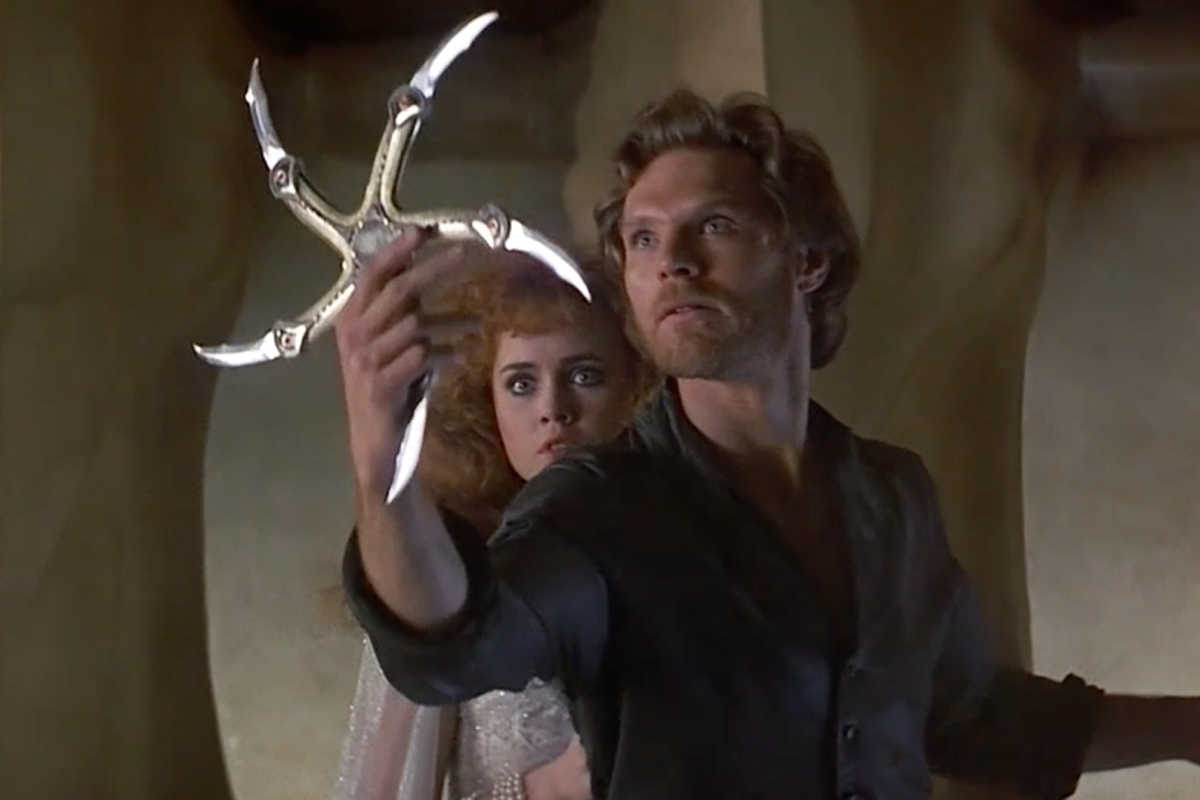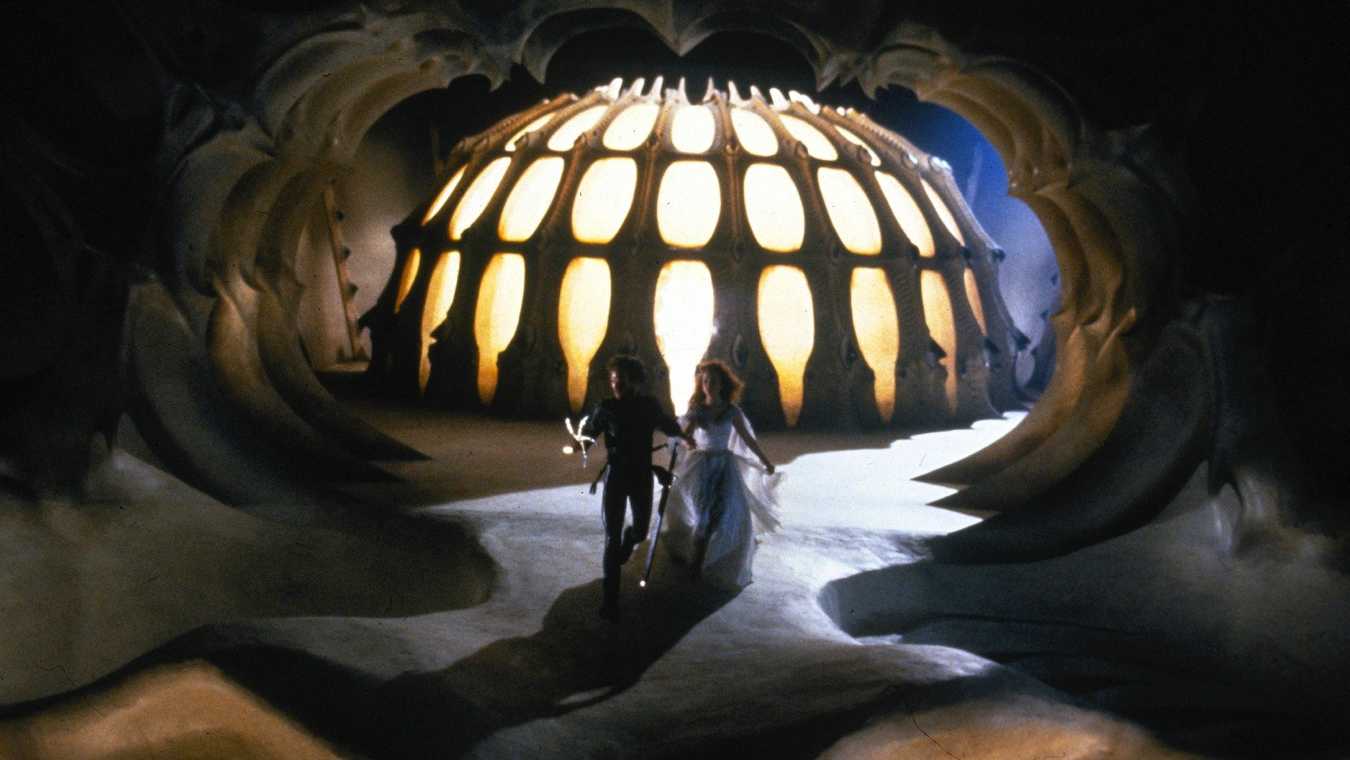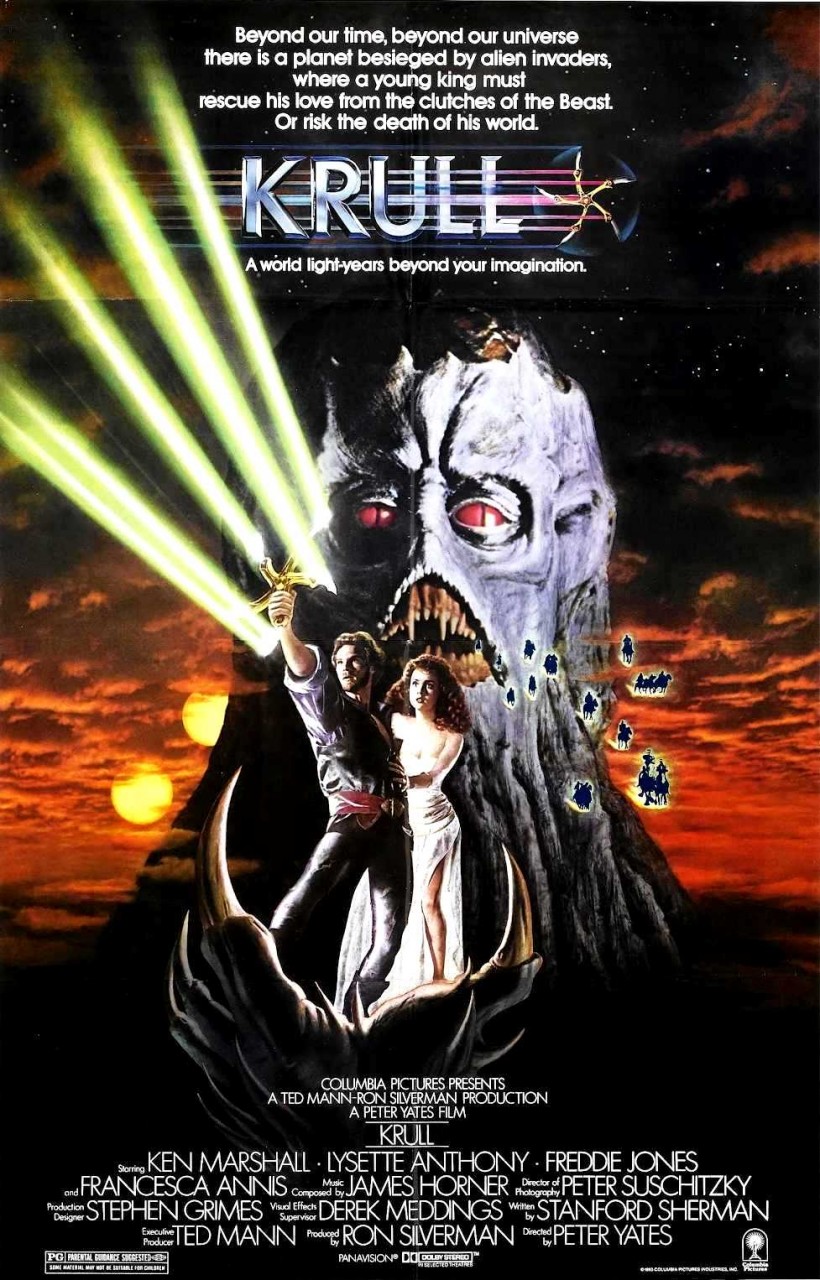UK. 1983.
Crew
Director – Peter Yates, Screenplay – Stanford Sherman, Producer – Ron Silverman, Photography – Peter Suschitzky, Music – James Horner, Visual Effects Supervisor – Derek Meddings, Stop Motion Animation – Steven Archer, Special Effects – John Evans & Mark Meddings, Makeup – Nick Maley, Production Design – Stephen Grimes. Production Company – Columbia.
Cast
Ken Marshall (Prince Colwyn), Lysette Anthony (Princess Lyssa), Freddie Jones (Ynyr), David Battley (Ergo), Alun Armstrong (Torquil), Bernard Bresslaw (Rell), John Welsh (Blind Seer), Francesca Annis (Widow of the Web)
Plot
A marriage is arranged between Prince Colwyn and Princess Lyssa to unite two kingdoms against the Beast that has invaded the world of Krull. Instead, the Beast’s Slayers abduct Lyssa and take her to the Beast who intends to marry her. Colwyn sets out to rescue her. He has difficulty in that the Beast’s Black Fortress teleports to a different random location all over Krull each day to avoid attack. Colwyn sets out on a quest to find a seer who can predict where the Black Fortress will materialise the next day. Along his journey, Colwyn unites a motley band of thieves, an apprentice magician and a cyclops.
When Star Wars (1977) came out, it was a blockbuster unlike anything people had seen before. Of course, such a success invariably creates a host of copycat films attempting to mimic the original. Most of these were conducted by people who understood little of science-fiction and only served redigested sf cliches up to the public – thus we had a host of lookalike films featuring intergalactic battles, tiny ships conducting unscientific Immelman turns in space, dark lords, cute robots and laser shootouts.
Krull is a perfect example of one of these copycat films being made by people who failed to understand anything about the genre. [The two most notorious examples would be Battlestar Galactica (1978) and The Black Hole (1979)]. The sense of miscalculation about the exercise was surely evidenced by the fact that the film was shot under the title The Dragons of Krull before people realised that there were no dragons in it, whereupon it then was simply released as the uninspiring Krull.
Peter Yates was a versatile director who had made films such as Bullitt (1968), The Friends of Eddie Coyle (1973), The Deep (1977), Breaking Away (1979) and Eyewitness (1981). Clearly, science-fiction/fantasy was one genre that neither Yates nor screenwriter Stanford Sherman had made any attempt to study or understand. The script is just naive and cliched and neither of them seem to have the energy that George Lucas imbued such cliches with in Star Wars, or even the vigour that a low-expectation sword-and-sorcery effort like The Sword and the Sorcerer (1982) manages to conduct them with. Star Wars cobblings turn up all over the place – lasergun shootouts, a ship rumbling over camera in the opening shot, a kidnapped princess, the heroes having to enter the Dark Lord’s castle to rescue her, a kindly wizard mentor.

Conceptually, the film is a bizarre hodgepodge – Krull came out just at the time when the Star Wars science-fiction cycle had birthed an interest in epic fantasy as well with successes like Excalibur (1981) and Conan the Barbarian (1982). Yates and Sherman have welded sword and sorcery onto intergalactic space opera without any seeming awareness of the incongruity – thus the cliched sinister Dark Lord is an alien monster, his castle is a spaceship, his armies fire laser guns and the fantasy kingdom is an alien planet. In trying to straddle both fads, the film ends up a bizarre mismatch.
All the cliches unfold in an unimaginative straight line. Peter Yates directs at a leaden pace, seemingly unable to imbue the film with the energy he put into say Bullitt, which is widely regarded as having one of the greatest ever film car chase sequences. There is much in the way of poor and conceptually shabby plotting. The hero is given a Great Ordeal to obtain the mystical Glaive but the ordeal consists only of dodging some falling rocks and dipping his hand into lava that never hurts him anyway, which is the sort of things that a hero like Conan might do before breakfast everyday – and when he does finds his weapon, what the film calls a glaive is not a glaive at all, it seems like a glorified shuriken when a glaive is in fact meant to be a sword. Nobody seems to consider how the giant unearthly Beast might consummate his marriage to Lyssa – for the squeaky clean film it is, the idea seems decidedly kinky.
This film cost a reputed $27 million, which was quite a large sum for a film in 1983. The effects team was headed by Derek Meddings, who supervised work on many of the James Bond films and Superman (1978), but the work is uncharacteristically shoddy in comparison to Meddings’ sterling craftsmanship elsewhere. The results often comes out little better effects-wise than the average episode of Doctor Who (1963-89). One can see the thick matte lines around people and the travelling matte footage behind the fire steeds is incredibly grainy. The monster is just a makeup job seen through a distorting lens (why is not apparent).

The sets are certainly imaginatively designed but it is a Saran-wrap world – they are so clean and sterile that they don’t seem remotely real. There is no dirt, no texture, no cultural depth in this world. In the opening scene, for instance, we see the prince’s castle, which just sits in the middle of nowhere – there are no surrounding villages or roads as one would expect, no peasantry walking in the background. There’s nothing in this world that suggests a history and culture stretching behind the people that inhabit it.
Ken Marshall is a boring hero. Lysette Anthony, while ravishing, makes one cringe the moment she opens her mouth. [Although this was only her film debut and she did improve considerably and go onto become a modestly effective actress in the likes of The Advocate (1993), Dr. Jekyll and Ms. Hyde (1995), Dracula: Dead and Loving It (1995) and the hilarious Misbegotten (1997)]. There are occasional moments from Bernard Bresslaw, Alun Armstrong and a young Liam Neeson. Composer James Horner’s score goes into melodramatic overdrive repeating the familiar ethereal trills from his Star Trek movie scores.
Trailer here


